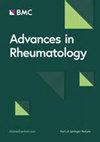Ultrasonographic and power doppler parameters of nails fail to differentiate between onychodystrophy in patients with psoriasis vulgaris or psoriatic arthritis
IF 2.1
4区 医学
Q3 RHEUMATOLOGY
引用次数: 0
Abstract
Nail involvement is frequent in patients with psoriasis (Pso) and psoriatic arthritis (PsA) and there is a relationship between nail involvement and inflammation of the enthesis. The main objective of the present study is to describe the ultrasound findings and clinical characteristics of nails from patients with psoriasis and psoriatic arthritis with and without nail dystrophy. A cross-sectional study including consecutive patients with PsO and PsA was carried out. The study patients were divided into 4 groups, totaling 120 participants. Group 1: patients with psoriasis vulgaris and clinically normal nails; Group 2: patients with psoriasis vulgaris and onychodystrophy; Group 3: patients with psoriatic arthritis and clinically normal nails; Group 4: patients with psoriatic arthritis and onychodystrophy; All patients were submitted to dermatological and rheumatological clinical analysis. Ultrasound examinations was performed by a single examiner, blinded to all clinical data, with ultrasound high resolution, in B-mode or gray-scale (GS), Power Doppler (PD) and Spectral Doppler. A significant difference was found between the groups regarding the variable Psoriasis Area and Severity Index (PASI) (p = 0.008) and body surface area (BSA) (p = 0.005), with patients with psoriatic arthritis having lower PASI and BSA compared to patients with only cutaneous psoriasis. A positive relationship was found with the average ultrasound thickness of the nail bed and the Nail Psoriasis Severity Index (NAPSI) in correlation analysis (rho = 0.344). When we grouped patients with psoriasis and psoriatic arthritis, there was no significant difference between the cutaneous psoriasis groups and the psoriatic arthritis groups in terms of nail plate GS (p = 0.442), nail bed PD (p = 0.124). Greater nail bed thickness indicates early psoriatic nail disease, as confirmed in our study correlating NAPSI with nail bed thickness. Ultrasonography is a low-cost exam, promising in the evaluation, showing that the ultrasound grayscale is consistent with those who have dystrophic nails, but it can’t distinguish psoriasis from psoriatic arthritis, even in those with nail dystrophy.指甲的超声波和功率多普勒参数无法区分寻常型银屑病和银屑病关节炎患者的甲软骨营养不良症
银屑病(Pso)和银屑病关节炎(PsA)患者的指甲经常受累,而指甲受累与内膜炎症之间存在一定的关系。本研究的主要目的是描述伴有或不伴有甲营养不良的银屑病和银屑病关节炎患者指甲的超声检查结果和临床特征。这项横断面研究包括连续的银屑病和银屑病关节炎患者。研究将患者分为 4 组,共 120 人。第 1 组:寻常型银屑病和指甲临床正常的患者;第 2 组:寻常型银屑病和甲营养不良的患者;第 3 组:银屑病关节炎和指甲临床正常的患者;第 4 组:银屑病关节炎和甲营养不良的患者;所有患者均接受了皮肤病学和风湿病学临床分析。超声波检查由一名检查人员进行,所有临床数据均为盲法,超声波分辨率高,采用 B 型或灰度(GS)、功率多普勒(PD)和频谱多普勒。在牛皮癣面积和严重程度指数(PASI)(P = 0.008)和体表面积(BSA)(P = 0.005)这两个变量上,各组之间存在明显差异,与仅患有皮肤银屑病的患者相比,银屑病关节炎患者的 PASI 和 BSA 较低。在相关分析中发现,甲床平均超声厚度与指甲银屑病严重程度指数(NAPSI)呈正相关(rho = 0.344)。当我们将银屑病和银屑病关节炎患者分组时,皮肤银屑病组与银屑病关节炎组在甲板GS(p = 0.442)、甲床PD(p = 0.124)方面没有显著差异。甲床厚度越大,表明银屑病指甲病变越早,这在我们将 NAPSI 与甲床厚度相关联的研究中得到了证实。超声波检查是一种低成本的检查方法,在评估中很有前景,它显示超声波灰度与指甲营养不良者一致,但它不能区分银屑病和银屑病关节炎,即使在指甲营养不良者中也是如此。
本文章由计算机程序翻译,如有差异,请以英文原文为准。
求助全文
约1分钟内获得全文
求助全文
来源期刊

Advances in Rheumatology
Medicine-Rheumatology
CiteScore
4.00
自引率
4.30%
发文量
41
审稿时长
53 weeks
期刊介绍:
Formerly named Revista Brasileira de Reumatologia, the journal is celebrating its 60th year of publication.
Advances in Rheumatology is an international, open access journal publishing pre-clinical, translational and clinical studies on all aspects of paediatric and adult rheumatic diseases, including degenerative, inflammatory and autoimmune conditions. The journal is the official publication of the Brazilian Society of Rheumatology and welcomes original research (including systematic reviews and meta-analyses), literature reviews, guidelines and letters arising from published material.
 求助内容:
求助内容: 应助结果提醒方式:
应助结果提醒方式:


